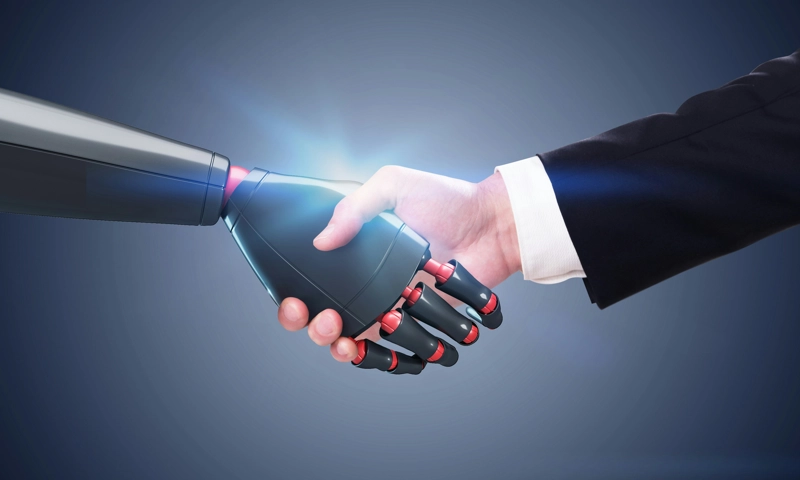-
The AI Efficiency Trap: When Productivity Tools Create Perpetual Pressure – Image Credit Unsplash+
AI is boosting productivity, but that doesn’t guarantee better working conditions for humans, writes Wharton’s Cornelia Walther.
The following article was written by Dr. Cornelia C. Walther, a visiting scholar at Wharton and director of global alliance POZE. A humanitarian practitioner who spent over 20 years at the United Nations, Walther’s current research focuses on leveraging AI for social good.
When artificial intelligence burst into mainstream business consciousness, the narrative was compelling: Intelligent machines would handle routine tasks, freeing humans for higher-level creative and strategic work. McKinsey research sized the long-term AI opportunity at $4.4 trillion in added productivity growth potential from corporate use cases, with the underlying assumption that automation would elevate human workers to more valuable roles.
Yet something unexpected has emerged from widespread AI adoption. Three-quarters (75%) of surveyed workers were using AI in the workplace in 2024, but instead of experiencing liberation, many found themselves caught in an efficiency trap — a mechanism that only moves toward ever higher performance standards.
What Is the AI Efficiency Trap?
The AI efficiency trap operates as a predictable four-stage cycle that organizational behavior experts have observed across industries. Critically, this cycle runs parallel to agency decay — the gradual erosion of workers’ autonomous decision-making capabilities and their perceived ability to function independently of AI systems.
Stage 1: Initial Productivity Gains and Experimentation
Organizations discover that AI can compress time-intensive tasks — financial modeling, competitive analysis, content creation — from days into hours. The immediate response is typically enthusiasm about enhanced capabilities. At the individual level, this stage represents cautious experimentation, where employees test AI tools for specific tasks while maintaining full control over decision-making processes. Agency remains high as workers actively choose when and how to employ AI assistance.
Stage 2: Managerial Recalibration and Integration
Leadership notices improved output velocity and quality. Operating under standard economic assumptions about resource optimization, managers adjust workload expectations upward. If technology can deliver more in less time, the logical response appears to be requesting more deliverables. Simultaneously, AI integration becomes normalized and technological habituation sets in. Workers begin incorporating AI into regular workflows, moving beyond occasional use to routine reliance for tasks like email drafting, preliminary research, and basic analysis. While workers still maintain oversight, their sense of agency begins subtly shifting as AI becomes an expected component of task completion.
Stage 3: Dependency Acceleration and Systematic Reliance
To meet escalating demands, employees delegate increasingly complex tasks to AI systems. What begins as selective assistance evolves into comprehensive reliance, with AI transforming from an occasional tool into an essential operational component. This stage marks a subtle step further on the scale of agency decay: Workers now depend on AI not just for efficiency but for core competency maintenance. Tasks that once required independent analysis — budget projections, strategic recommendations, client communications — become AI-mediated by default. This stage triggers skill atrophy, where underused capabilities begin to deteriorate, further reinforcing AI dependency.
Stage 4: Performance Expectation Lock-in and AI Addiction
Each productivity improvement becomes the new baseline. Deadlines compress, project volumes expand, and complexity increases while maintaining existing headcount and resources. The efficiency gains become permanently incorporated into performance standards. Concurrently, workers reach what researchers term “technological addiction” — a state where AI assistance becomes psychologically necessary rather than merely helpful. Agency decay reaches its most severe stage: Employees report feeling incapable of performing their roles without AI support, even for tasks they previously managed independently. Workers at this stage experience anxiety when AI systems are unavailable and demonstrate measurably reduced confidence in their autonomous decision-making abilities.
This cycle creates a classic “Red Queen” dynamic, borrowed from evolutionary biology, where continuous and accelerating adaptation is required simply to remain competitive. As this dynamic plays out simultaneously at individual and institutional levels — both internally among employees and externally between companies — the relentless pace of innovation enters a race of no return.

Consequences of the AI Efficiency Trap The Agency Decay Phenomenon
The erosion of human agency represents perhaps the most concerning long-term consequence of the AI efficiency trap. Agency, defined as both the ability and volition to take autonomous action plus the perceived capacity to do so, undergoes systematic degradation through the four-stage cycle.
This self-perception shifts measurably, with studies showing a statistically significant decrease in perceived personal agency correlating directly with increased trust in and reliance on AI systems. Workers report feeling progressively less capable of independent judgment, even in domains where they previously demonstrated expertise.
This creates a feedback loop that reinforces the AI efficiency trap: As workers lose confidence in their autonomous capabilities, they become more dependent on AI assistance, which further accelerates both productivity expectations and skill atrophy. The result is learned technological helplessness — a state where workers believe they cannot perform effectively without AI support, regardless of their actual capabilities.
The implications extend beyond individual psychology to organizational resilience. Companies with workforces experiencing advanced agency decay become vulnerable to AI system failures, regulatory restrictions, or competitive disadvantages when AI access is compromised. The efficiency gains that initially provided competitive advantage can transform into critical dependencies that threaten organizational sustainability.
The Hidden Psychological Costs
The psychological toll of this efficiency treadmill is becoming increasingly apparent in workplace research. A survey of 1,150 U.S. workers in 2024 revealed that three in four employees expressed fear about AI use and were concerned it may increase burnout. These statistics suggest that technology designed to reduce cognitive load is creating new forms of mental strain, rather than creating genuine opportunities for strategic thinking or professional development.
As time savings in one area immediately convert to increased expectations in the same domain, efficiency substitution sets in; workers who experience this dynamic report feeling simultaneously more productive and more overwhelmed. The cognitive assistance that should create space for higher-order thinking instead fills schedules with exponentially increased task volumes.
The Perpetual Availability Problem
Modern AI assistants further heat up the workplace myth of perpetual availability. Unlike human colleagues who observe boundaries around working hours, AI tools remain ready to generate reports, analyze data, or draft presentations at any hour. This constant accessibility paradoxically reduces human autonomy rather than enhancing it.
The psychological pressure to utilize round-the-clock availability creates a sort of digital omnipresent stress. The consequences of digital overload as a consequence of social media have been known for a decade, yet with AI assistants that can produce deliverables 24/7, this dynamic is taken to a whole new level. The boundary between productive work and recovery time dissolves.
Economic Forces Amplifying the AI Efficiency Trap
The efficiency conundrum isn’t merely about individual productivity preferences — it’s embedded in competitive economic dynamics. In increasingly competitive markets, organizations view AI adoption as existentially necessary. Companies that don’t maximize AI-enabled productivity risk being outcompeted by those that do.
This creates what game theorists recognize as a collective action problem. Individual organizations making rational decisions about AI utilization lead to collectively irrational outcomes — unsustainable productivity expectations across entire industries. Each company’s efficiency gains become the new competitive baseline, forcing all participants to accelerate their AI utilization or risk market displacement. AI safety frameworks become a secondary consideration, with uncomfortable questions of accountability.
The result is an industry-wide productivity arms race where the benefits of AI efficiency gains are rapidly competed away, leaving workers with higher performance expectations but not necessarily better working conditions or compensation. This set in the context of growing fear of automation and a decrease in human labor feeds a perfect storm.
We are making ourselves ever more dependent on the assets that are making us redundant.
The erosion of human agency represents perhaps the most concerning long-term consequence of the AI efficiency trap.
How Leaders Can Address the Challenge
The prevailing conundrum presents a significant challenge for business leaders who must navigate between competitive market pressure and employee well-being. The most successful approaches involve conscious AI integration — deliberately designed systems that enhance human capability without overwhelming human workers. Hybrid intelligence, arising from the complementarity of natural and artificial intelligences, seems to be the best guarantee to ensure a sustainable future for people, planet, and profitability.
This requires leadership teams to resist the intuitive assumption that faster tools should automatically generate more output. Instead, organizations need frameworks for deciding when AI efficiency gains should translate to increased throughput versus when they should create space for deeper analysis, creative thinking, or strategic planning.
Research conducted before the AI bust indicates that companies maintaining this balance demonstrate stronger long-term performance metrics, including innovation rates, employee engagement scores, and client satisfaction measures.
A Framework for Balanced Integration
Organizations seeking to escape the AI efficiency trap can benefit from the POZE framework for sustainable AI adoption:
Perspective — Maintain strategic viewpoint over tactical acceleration. Focus on long-term organizational health rather than short-term productivity maximization. Regularly assess whether AI efficiency gains are supporting strategic objectives or merely creating busywork at higher speeds.
Optimization — Optimize for value creation, not volume production. Measure the quality and business impact of AI-assisted work rather than simply counting outputs. Recognize that peak AI utilization may not correspond to peak organizational performance or employee well-being.
Zeniths — Establish explicit peak boundaries for AI-driven expectations. Set maximum thresholds for workload increases following AI implementation to prevent the automatic escalation that characterizes the efficiency trap. Create “zenith policies” that cap productivity expectations even when technological capabilities could support higher output.
Exposure — Monitor and limit organizational exposure to agency decay risks. Conduct regular assessments of employee confidence in autonomous decision-making. Preserve critical human judgment capabilities by maintaining AI-free zones for strategic thinking, creative problem-solving, and relationship building.
This framework acknowledges that the most productive AI implementations may be those that create sustainable competitive advantages through enhanced human capabilities rather than simply accelerating existing work processes. The POZE approach helps organizations maintain the strategic perspective necessary to harness AI’s benefits while avoiding the psychological and operational pitfalls of the efficiency trap.
Looking Forward
The AI efficiency trap is one of the defining challenges of our era. What begins as a promise of liberation through automation all too often becomes a productivity prison. Yet simply naming this paradox opens the door to smarter strategies for AI adoption.
Rather than allowing technology’s raw capabilities to dictate human workload, leading organizations will use AI to amplify our uniquely human strengths — curiosity, compassion, creativity, and contextually relevant strategic foresight — so that people remain at the heart of value creation. In doing so, they preserve the cognitive space where true innovation and long-term competitive advantage are born.
The AI efficiency trap is not an unavoidable fate but a design choice. By embedding deliberate frameworks and conscious leadership into every stage of AI implementation, we can reclaim the original promise of automation as a tool for genuine human empowerment.
This article originally appeared on Knowledge@Wharton.

















